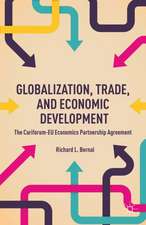Economic Growth and Income Disparity in Bric
Autor Monica Das, Sandwip Kumar Dasen Limba Engleză Hardback – 22 sep 2013
Preț: 517.07 lei
Preț vechi: 608.32 lei
-15% Nou
Puncte Express: 776
Preț estimativ în valută:
98.94€ • 103.58$ • 81.87£
98.94€ • 103.58$ • 81.87£
Carte tipărită la comandă
Livrare economică 07-21 aprilie
Preluare comenzi: 021 569.72.76
Specificații
ISBN-13: 9789814415910
ISBN-10: 981441591X
Pagini: 168
Dimensiuni: 154 x 237 x 16 mm
Greutate: 0.44 kg
Ediția:New.
Editura: World Scientific Publishing Company
ISBN-10: 981441591X
Pagini: 168
Dimensiuni: 154 x 237 x 16 mm
Greutate: 0.44 kg
Ediția:New.
Editura: World Scientific Publishing Company
Descriere
The interest in the development processes of BRIC countries (Brazil, Russia, India and China) has been triggered by their high growth performance. But their political and social background is entirely different. In this study, two inequality measures applied are Gini Coefficient and Theil's entropy measures, depending on data availability.










